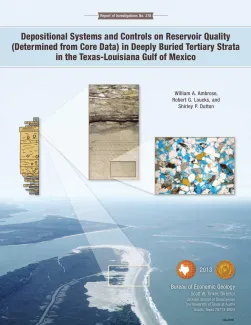
Publication Details
Geolocation:
Get the Publication
$12.50
Abstract/Description:
A study of the deeply buried (>10,000 ft [>3,050 m]) Tertiary section in the Gulf of Mexico, which makes use of whole cores from 12 wells in Louisiana and Texas, provides a framework for interpreting depositional origin and demonstrates that relative position within the sequence-stratigraphic framework and facies tract can exert powerful controls on reservoir quality, even in deeply buried successions. Some wells in the Texas-Louisiana Gulf of Mexico in deep (>19,000-ft [>5,790-m]) sandstones of deep-water origin in the lower Wilcox Group have comparable porosity and permeability values relative to those in shallower (<13,500-ft [<4,115-m]) lower Wilcox shallow-marine highstand and transgressive systems tracts, although porosity values and relative abundance of porosity types (intergranular, secondary, and microporosity) vary between these cores. Similar examples occur in the Frio Formation, where deep-water sandstones of lowstand origin in southwest Louisiana, associated with sediment bypass, have values of 20 to 30 percent porosity and more than 1 darcy (D) permeability, although they are more than 16,000 ft (>4,878 m) deep. Facies variability, mineralogical composition, and sequence-stratigraphic origin are additional factors that influence porosity and permeability. Considerable variation exists in porosity and permeability values between deltaic and shoreface sandstones, as well as between transgressive and progradational sandstones in deeply buried strata in the Gulf of Mexico. Similar variation also exists in porosity and permeability values between turbidite channel-fill, levee overbank, and debris-flow sandstones in deep-water systems in the Wilcox Group and Yegua Formation. Regions where higher reservoir quality may exist in the deep subsurface are delineated by integrating sequence stratigraphy, facies variability, mineralogy, and environmental parameters such as temperature and pressure. These data are correlated to empirical reservoir quality from wireline logs and cores to infer facies controls on reservoir quality.